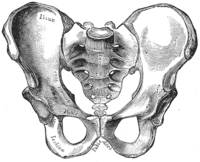
Photo from wikipedia
AIM To report the surgical outcomes of correcting large angle intermittent exotropia in adult patients by bilateral lateral rectus muscle recession with intraoperative use of botulinum toxin and to compare… Click to show full abstract
AIM To report the surgical outcomes of correcting large angle intermittent exotropia in adult patients by bilateral lateral rectus muscle recession with intraoperative use of botulinum toxin and to compare the results with those of bilateral lateral rectus muscle recession and unilateral medial rectus resection. METHODS The medical records of patients who underwent surgical correction of large angle intermittent exotropia [exotropia >50 prism dioptre (PD)] were retrospectively reviewed. Two groups of patients were identified; Group I (21 patients) had bilateral lateral recti recession augmented with intraoperative botulinum toxin A (BTA) injection into the recessed muscles and group II (30 patients) were treated by bilateral lateral recti recession with unilateral medial rectus muscle resection. Preoperative data were extracted for age, gender, refraction, type of exotropia, angle of stereopsis and angle of deviation. The main outcome measures were the postoperative angle of deviation and stereoacuity angle by Titmus test measured at the end of one year of postoperative follow up. RESULTS By the end of the first postoperative year, 10 patients in group I (47.6%) and 20 patients in group II (66.7%) achieved esotropia/esophoria <5 PD or exotropia/exophoria <10 PD. The difference in surgical success rate was not statistically significant (P=0.1) but there was a statistically significant higher rate of undercorrection in group I (P=0.03). On the other hand, 3 patients in group I (14.3%) and 5 patients in group II (16.7%) had improved stereopsis; this difference in the sensory outcome was not statistically significant (P=0.8). In the BTA augmented surgery group, good stereoacuity and smaller preoperative angle of deviation were associated with significantly higher surgical success rate (P=0.004, 0.01 respectively). CONCLUSION BTA augmented bilateral lateral recti recession is associated with higher rate of undercorrection as compared to bilateral lateral recti recession with unilateral medial rectus resection in the correction of large angle intermittent exotropia. The surgical success rate in BTA augmented surgery group is observed to be higher in patients with preoperative smaller angle of deviation and in patients with good stereoacuity.
Journal Title: International journal of ophthalmology
Year Published: 2022
Link to full text (if available)
Share on Social Media: Sign Up to like & get
recommendations!